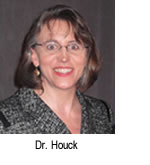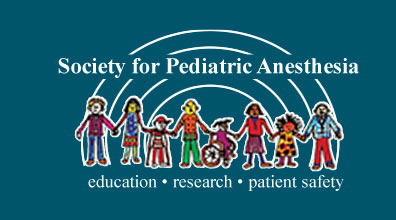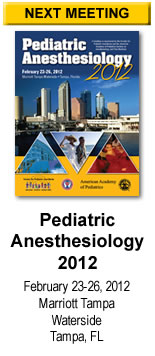2011 SPA & AAP Breakfast Panel Review
 By Constance S. Houck, MD
By Constance S. Houck, MD
Children’s Hospital, Boston
This year’s SPA & AAP Breakfast Panel was entitled “Controversies in the Anesthesia Management of Adenotonsillectomy in Children” and the audience completely filled the large conference room.
The first speaker was Dr. Rahul Baijal from Texas Children’s Hospital who spoke about awake vs. deep extubation. He provided an extensive review of the available literature describing the incidence of laryngospasm after these two different forms of extubation which did not reveal any advantage of one technique over the other. Only one small study without a comparison group by Tsui et al (Tsui 2004) demonstrated a very low incidence of laryngospasm after a no touch awake extubation in the lateral position.
He then discussed various techniques and medications used to reduce laryngospasm and again showed a paucity of evidence supporting the effectiveness of lidocaine, fentanyl or dexmedetomidine but some efficacy for propofol and magnesium in minimizing laryngospasm. Since no clear advantage could be determined, he emphasized the importance of recognizing those patients who are high risk for airway complications and assuring the immediate availability of expert personnel needed to handle acute airway complications after tonsillectomy.
The second talk was by Dr. Deb Schwengel from Johns Hopkins who began by describing the unfortunate death of two 3 year old twins with OSA who died at home after otherwise uneventful outpatient tonsillectomies. They had evidence of OSA for at least a year along with poor growth but no sleep study was done preoperatively. Postmortem studies revealed both to be poor metabolizers of codeine and the doses of morphine and codeine that the children received in the perioperative period were appropriate.
Dr. Schwengel went on to describe the increased risk of respiratory complications after T&A (the most common cause of death or morbidity in malpractice claims) in children with OSA. She described data from a number of recent studies that demonstrate that children without OSA have a < 1% incidence of airway complications compared to 11 – 26% of children with OSA and 40 – 60% of children with severe OSA. She also outlined the recent studies by Karen Brown and others that demonstrate that children with severe OSA have altered central opioid sensitivity and increased respiratory depression with standard doses of opioids.
She also highlighted a recent study by Ravendran et al that showed that if children with OSA were given IV dexamethasone and a lower dose of morphine, the incidence of major respiratory complications decreased from 30% to 11%. Many ORL surgeons have become more comfortable with the use of NSAIDs postoperatively to decrease these types of complications and a 2005 Cochrane collaborative review demonstrated no increase in bleeding and reduced PONV when NSAIDs were part of the postoperative pain control regimen.
A recent survey in the UK revealed that 77% of clinicians administer NSAID’s (including diclofenac and ibuprofen) to their T&A patients. In order to prevent similar tragedies, Dr. Schwengel recommended the following:
- Preoperative testing for all children with sleep disordered breathing should be encouraged,
- Children with sleep disordered breathing with no formal testing should not be sent home with opioid analgesics,
- A normal opioid dose is an overdose in children with severe OSA,
- Adjuvant analgesics should be considered to treat pain and reduce respiratory side effects, and
- Patients with severe disease or unknown severity of disease should be admitted overnight.
Dr. Franklyn Cladis from Pittsburgh Children’s concluded the session with a review of the particular risk factors that have been shown to predict an increase in respiratory complications after T&A. These include:
- Age < 3,
- Comorbidities such as craniofacial abnormalities, Down syndrome, neuromuscular disease, prematurity and obesity, and
- An apnea/hypopnea index (AHI) > 10 and O2 sat nadir during sleep < 85%. He specifically recommended the guidelines that Dr. Schwengel proposed in her review in 2009 which includes a detailed history and physical for all children who have not undergone a sleep study.
This includes a specific history regarding snoring, breathing difficulties during sleep and nighttime sweating. He proposed the following guidelines for ambulatory T&A:
- Patients should be at least 3 years of age,
- They should have no significant co-morbidities, and
- Discharge should be at least 2 hours after the last dose of morphine. He also recommended several strategies to reduce risk including lowering the dose of opioids, using dexamethasone to reduce airway swelling and careful patient selection.


